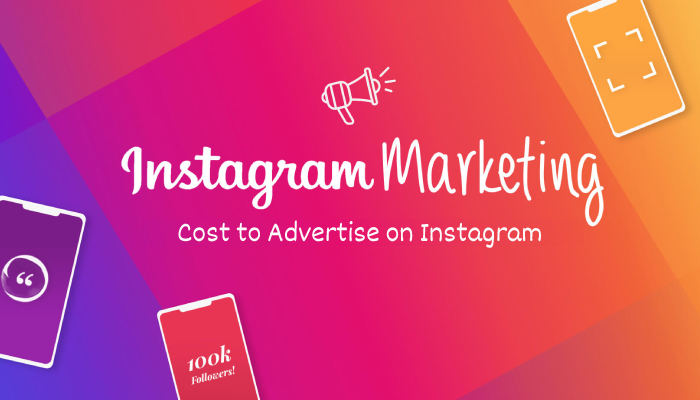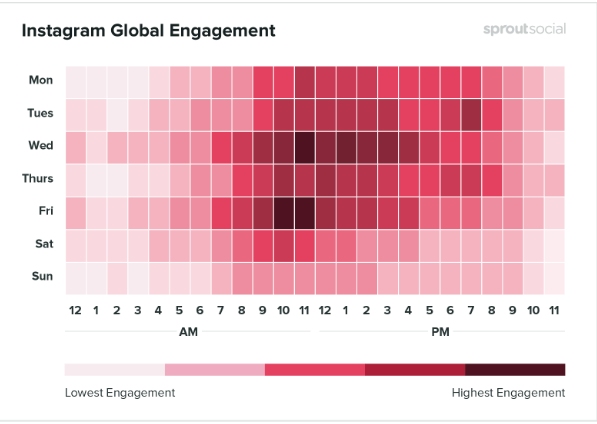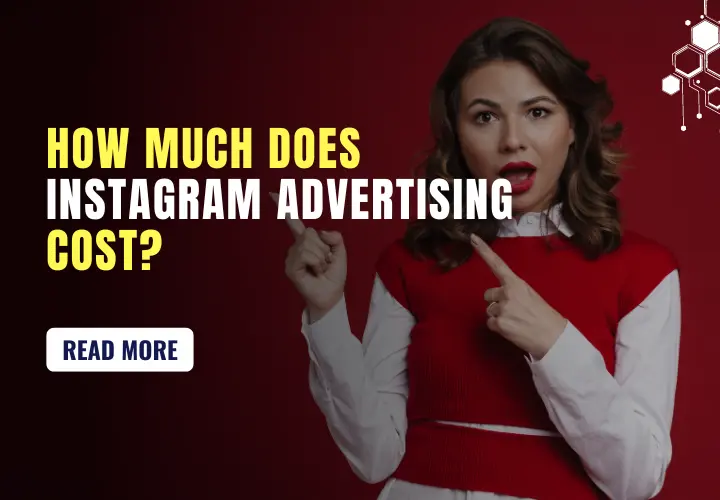How Much Does Instagram Advertising Cost?
The average cost of Instagram advertising that experts share varies significantly. While some experts say that Instagram advertising can cost you anywhere between $0.20 and $6.70 based on the bidding model (CPC or CPM), others state that you can expect to pay between $0.40 and $3 for a click.
On the other hand, many digital experts think that link cost per click (for ads with a destination URL) will range from $0.50 to $0.95, and cost per click (all metrics) will range from $0.40 to $0.70, and cost per 1,000 impressions (CPM) is ranging between $2.50 and $3.50.
If you are a business owner or marketer looking to reach a massive audience and promote your products or services, Instagram advertising is something you should consider.
With over 1.4 billion active users, Instagram offers an incredibly vast and engaged community that you can tap into.
Instagram’s advertising costs can vary widely depending on several factors, such as your industry, target audience, advertising goals, and the type of ad you are running.
Some businesses might be able to get away with spending just a few dollars per day, while others might need to shell out hundreds or even thousands to see meaningful results.
So, if you are ready to look into Instagram advertising, get ready to explore the various factors that determine how much you will need to invest to make your campaigns a success.
Basics of Instagram Advertising Pricing
How much does Instagram advertising cost?
|
Average CPC (Cost Per Click) |
30% of companies pay |
$0.00 – $0.25 |
|---|---|---|
|
Average CPM (Cost Per Impression) |
46% of companies pay |
$0.00 – $4.00 |
|
Average CPE (Cost Per Engagement) |
54% of companies pay |
$0.03 – $0.08 |
Source: WebFX
- A statistics report published by Kepios shows a 12.2% year-over-year increase in ad reach.
- Instagram ad revenue will reach $59.6 billion in 2024.
- Brafton’s report shows that the CTR for feed ads on Instagram ranges from 0.22% to 0.88%, and story ads have a CTR between 0.33% and 0.54%.

How much does Instagram advertising cost per month?
Instagram advertising costs nearly $0.00–$500.00 per month, and each month, 11% of marketers spend more than $5000.00 on Instagram advertising.
How much does Instagram advertising cost per click?
Instagram ads cost $0.00–$0.75 per click, which is 59% of respondents. Whereas, 19% of marketers spend over $2.00 per click.
How much does Instagram advertising cost per 1,000 impressions?
Instagram ads cost $0.00–$6.00 per 1000 impressions. 10% of respondents spent more than $10.00.
How much does Instagram advertising cost in terms of engagement?
Instagram ads cost $0.03–$0.08 per engagement, which is 54% of respondents. 19% of marketers pay more than $0.11 per engagement.
What Are The Cost Factors for Instagram’s Advertising?
1. Advertising Objective
The goal you’re trying to achieve with your Instagram ad campaign plays a significant role in determining the cost.
For example, campaigns aimed at driving website traffic or online sales (known as conversion campaigns) tend to be more expensive than those focused on brand awareness or video views. Users are being asked to take more valuable action, so competition and costs are higher.
2. Target Audience
The size and characteristics of your target audience can greatly impact advertising costs. If you’re targeting a highly specific or niche audience, you’ll likely face less competition from other advertisers, which can translate to lower costs.
However, if you’re going after a broad, popular audience (like millennials or new parents), you’ll be competing with many other brands, driving up prices.
3. Ad Placements
Instagram offers several ad placements, and the costs can vary depending on where your ad appears. Feed ads, which show up in users’ main Instagram feeds, tend to be more expensive than story ads, which appear between friends’ stories.
Ads in the Explore section or within specific Instagram accounts (known as sponsored posts) can also carry different price tags.
4. Industry and Competition
Some industries are simply more competitive on Instagram than others, leading to higher advertising costs.
For example, fashion, beauty, and e-commerce brands often face steeper competition (and price tags) than businesses in niche or less-saturated markets like industrial equipment or plumbing services.
5. Ad Quality and Relevance
Instagram’s algorithm prioritizes high-quality, relevant ads, and it rewards advertisers who create engaging, visually appealing content by offering lower costs and better placements.
Ads with compelling visuals, persuasive copy, and a smooth user experience are more likely to perform well and cost less than subpar ads.
6. Bidding Strategy
Instagram uses an auction-based system for advertising, where advertisers bid on ad placements. The bidding strategy you choose cost-per-click (CPC) or cost-per-impression (CPM)—can impact your costs.
CPC ads, where you pay for each click, may be more expensive overall but can be more cost-effective if you’re driving high-intent traffic.
7. Ad Scheduling and Budgeting
The timing and budget you set for your Instagram ads can also influence costs. Advertising during peak hours or popular events when competition is high can drive up prices.

Image Source: SproutSocial
Setting daily or lifetime budgets can help you manage your spending effectively and avoid overpaying for ad placements.
8. Testing and Optimization
While Instagram advertising can be pricey, consistent testing and optimization can help you stretch your budget further.
By analyzing your ad performance data and making tweaks to your targeting, creatives, and bidding strategies, you can gradually improve your return on ad spend (ROAS) over time.
Are Instagram’s Advertising Costs Worthy Enough?
- Instagram has become a popular platform for businesses to advertise their products and services.
With its highly visual nature and vast user base, it offers a lucrative opportunity for companies to reach a wide audience.
- However, advertising on Instagram comes with a cost. Companies have to pay for sponsored posts, influencer collaborations, and other forms of promotion. The question arises: Are these costs justified, or do they outweigh the potential benefits?
Exploring the Benefits:
- Targeted Reach: Instagram’s advertising platform allows businesses to target specific demographics, interests, and locations, ensuring that their ads reach the right audience.
- Visually Appealing: Instagram’s emphasis on visuals makes it an ideal platform for showcasing products and services in an aesthetically pleasing manner.
- Influencer Marketing: Partnering with influencers can help businesses tap into established followings and leverage the trust and credibility of these individuals.
Considering the Drawbacks:
- Advertising Costs: Instagram’s advertising costs can be significant, especially for smaller businesses or those operating on tight budgets.
- Algorithm Changes: Instagram’s algorithms constantly evolve, and businesses may need to adapt their strategies to maintain visibility and engagement.
- Saturated Market: With many businesses vying for attention on the platform, it can be challenging to stand out and capture users’ interest.
Evaluating the Return on Investment (ROI):
- Increased Brand Awareness: Successful Instagram campaigns can significantly boost brand awareness and recognition.
- Measurable Results: Instagram provides analytics tools that allow businesses to track the performance of their ads and measure key metrics like engagement, clicks, and conversions.
- Long-term Growth: By cultivating a strong presence on Instagram, businesses can build lasting relationships with their target audience and drive long-term growth.
Instagram ads cost around $0.20-$2.00 on average per click, while CPM averaged $6.70. However, these costs can vary significantly based on the factors discussed earlier.
Also Read: Instagram Advertising Can Help You Increase Your Business
How Instagram Advertising Works?
Instagram ads are a powerful way for businesses to reach their target audience on one of the most popular social media platforms.
1. Ad Creation and Targeting
Businesses can create ads directly on Instagram or through Facebook’s Ads Manager. Ads can feature single images, carousels (multiple images), videos, or Instagram Stories. Instagram offers advanced targeting options, allowing businesses to reach users based on factors like location, age, interests, and behaviors.
2. Ad Placement
Instagram ads can appear in various places within the app, including the main feed, Stories, Explore tab, and even between users’ Stories.
3. Budgeting and Bidding
Businesses set their desired budget for each ad campaign, with options for daily or lifetime budgets. Instagram uses an auction-based system, where businesses bid to have their ads shown to specific audiences.
Factors like targeting, ad quality, and bid amount determine the cost and placement of ads.
4. Ad Performance and Optimization
Instagram provides detailed analytics on ad performance, including impressions, reach, clicks, and conversions. Businesses can use these insights to optimize their ads, refine targeting, and get the most out of their advertising budget.
5. Influencer Marketing and Sponsored Posts
In addition to traditional ads, businesses can partner with influencers for sponsored posts. Influencers with large, engaged followings can create sponsored content that feels authentic and resonates with their audience.
These sponsored posts are labeled “Paid Partnership” to maintain transparency.
6. Shopping and E-commerce Integration
Instagram has integrated shopping features, allowing businesses to tag products in posts and stories, making it easier for users to shop directly from the app. A seamless integration between advertising and e-commerce can drive sales and increase conversions.
Also Read: Why & How to Use Instagram Shopping to Boost Your Online Business
How Can You Lower The Cost of Your Instagram Ads?
While Instagram advertising costs can be substantial, there are strategies businesses can employ to optimize their ad spend and potentially reduce costs:
- Refine Targeting: Carefully refine your targeting options to reach the most relevant audience. Overly broad targeting can lead to higher costs and lower engagement.
- Optimize Ad Creative: Continuously test and optimize your ad creative (images, videos, copy) to improve relevance and engagement, which can lower costs over time.
- Use Instagram Analytics: Utilize Instagram’s built-in analytics tools to identify high-performing ad sets and audiences, and reallocate your budget accordingly.
- Experiment with Ad Placements: Test different ad placements (feed, stories, and explore) to find the most cost-effective options for your business.
- Automate Bid Strategies: Consider using Instagram’s automated bid strategies, which use machine learning to optimize your bids for better cost efficiency.
- Incorporate Retargeting: Implement retargeting strategies to reach users who have already engaged with your brand, as they tend to have higher conversion rates and lower acquisition costs.
Is Advertising on Instagram Free?
If you want to run ads on Instagram, you must have a Facebook Page to run ads. Once you have it, you can create your business profile on Instagram for free.
Yes, you can promote your products and services on Instagram free of cost with a well-thought-out strategy. In that case, you must have highly engaging ads that offer value to your followers and compel them to share them with others increasing the reach of your ads. Contact Instagram Support if you encounter any issues during this process, can guide you in crafting effective ad strategies.
But it does not always work. Even after having amazing videos and making enormous efforts to write valuable content, the reach of your content stays limited. In that case, Instagram ads come to your rescue to help you enjoy greater exposure.
Are Instagram Ads Cheaper Than Facebook Ads?
Instagram users are better at embracing ads more readily than Facebook users. Ads on Instagram receive higher engagement rates and that too organically. The engagement is higher specifically on video ads. So, no, the cost per click (CPC) of Instagram ads is not lower than that of Facebook ads.
The average CPC of Instagram advertising is $3.56 while the average CPC of Facebook advertising is $0.97. Falcon.io says the average CPCs of Instagram ads and Facebook ads are $1.28 and $0.51. On the other hand, Agorapulse’s research found that the CPC on Facebook is 42.86% lower than the CPC on Instagram.
While you can see a significant difference between the price ranges, you can easily conclude that Instagram ads are not cheaper. However, you should not change your mind about advertising on Instagram because experts also admit that the results you see with Instagram are better and Instagram ads get more quality clicks when compared to Facebook.
Also Read: How Much Does Facebook Advertising Cost?
What Kinds of Ads You All Can Use on Instagram?
Instagram offers a variety of ad formats to help businesses reach their target audience effectively.
Let’s explore the different types of ads you can use:
1. Photo Ads
- These are single-image ads that appear in users’ feeds, blending seamlessly with regular posts.
- Photo ads are great for showcasing products, highlighting promotions, or sharing visually appealing content.
2. Video Ads
- Video ads allow you to capture users’ attention with engaging, short video clips.
- They can appear in feeds or as Instagram Stories ads, perfect for showcasing product demos or telling brand stories.
3. Carousel Ads
- Carousel ads consist of multiple images or videos that users can swipe through.
- This format is ideal for showcasing different angles of a product, highlighting multiple offerings, or telling a sequential story.
4. Stories Ads
- These full-screen ads appear in users’ Instagram Stories, capturing their attention as they browse.
- Story ads are great for promoting limited-time offers, new product launches, or driving website traffic.
5. Collection Ads
- Collection ads feature a cover image or video, along with a grid of product images below.
- Users can tap on specific products to learn more or make a purchase, making this format perfect for e-commerce businesses.
6. Branded Content Ads
- These ads are created in collaboration with influencers or content creators.
- Branded content ads leverage the credibility and reach of influencers, helping your brand connect with its engaged audiences.
7. Explore Ads
- Explore ads appear in the Explore feed, where users discover new content and accounts based on their interests.
- These ads can help you reach users who may not be following your account yet.
Also Read: Are Instagram Ads Useful For Digital Marketing?
Is there any way to save money on Instagram advertising?
Yes, there are not one but many ways that can help you produce cost-effective Instagram ads.
Some of these are:
- Select campaign objectives that are funnel-appropriate. Build your customer funnel based on user behavior.
- Allow your followers to explore and shop your offerings without leaving Instagram.
- Use automatic bidding so that you don’t overspend on ads. Sometimes, marketers tend to spend more money than they need so that they can outbid others. This, in fact, is not good for a cost-effective advertising model.
- Test your target audiences with different ad variations to find what resonates with them the most. It can improve engagement rates and CTR and that, in turn, will lower Instagram advertising costs.
Conclusion
Instagram advertising presents a valuable opportunity for businesses to reach and engage with a highly targeted and visually oriented audience.
While the costs can vary significantly based on factors like targeting, ad placement, and industry competition, many businesses find the investment worthwhile due to Instagram’s unique advantages, such as a highly engaged user base, visual storytelling capabilities, and advanced targeting options.
The key to successful Instagram advertising lies in understanding your target audience, creating compelling ad experiences, and continuously refining your approach based on performance data.
Latest posts by Vijaya Tyagi (see all)
How To Track Shopify SEO Performance & Metrics (2025) - January 14, 2025
Link Building Strategies: The Ultimate Techniques for 2025 - December 31, 2024


